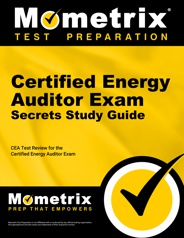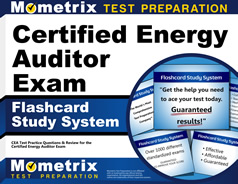The Certified Energy Auditor (CEA) exam is designed by the Association of Energy Engineers (AEE) to evaluate individuals seeking to become certified energy auditors.
Click “Start Test” above to take a free Certified Energy Auditor practice test!
Exam Eligibility
To sit for the CEA certification exam, you must meet several criteria, including attending a mandatory CEA training preparation seminar offered by an AEE-approved training provider, either nationally or internationally depending on where you reside and work. To qualify, you must meet at least one of the following criteria:
- Possess a 4-year engineering or architectural degree, or Registered Architect (RA) or Professional Engineer (PE), and 3 or more years of related experience
- Possess a 4-year degree in an unrelated field and 4 or more years of related experience
- Possess a 2-year degree (associate level), and 5 or more years of related experience
- Possess a current Certified Energy Manager (CEM) credential and 3 or more years of related experience
Certified Energy Auditor Exam Outline
The Certified Energy Auditor exam contains 120 multiple-choice questions, 20 of which are unscored, and you will be given a time limit of 4 hours. The 20 unscored questions are used to evaluate the questions for future versions of the exam.
The exam is split into 12 sections.
1. Developing an Energy Audit and Strategy Plan (9%-13%)
The questions in this section assess your knowledge and skills in the following areas:
- Planning an energy audit
- Defining required audit procedures
- Defining the project team
- Determining an appropriate audit level
- Defining pre-audit tasks
- Defining the data and instrumentation required for energy analysis
- Communicating procedures and data gathering
- Identifying operations and the maintenance team and creating pre-audit O&M interview questions
- Defining audit report format and requirements
- Drafting audit report/final audit report
- Conducting audit follow-up
- Supporting ISO 50001 Energy Management Systems
- Understanding industry standards
- Awareness of code, legal, industry-specific energy requirements
2. Energy Use Analysis (7%-11%)
The questions in this section assess your knowledge and skills in the following areas:
- Defining required energy usage and other information
- Reviewing rate classifications
- Establishing utility/costs baseline
- Establishing utility/energy usage baseline
- Establishing relevant variables, regression analysis, and energy performance indicators
- Analyzing energy use graphs
- Facilitating benchmarking, targets, EUI, ECI, load factor, and savings potential
- Analyzing and breaking down energy end-use
- Utilizing balance point temperature
- Analyzing fleet information
3. Data Collection and Analysis (8%-12%)
The questions in this section assess your knowledge and skills in the following areas:
- Defining and collect pre-site data
- Defining and collect on-site data
- Determining EEMs to be evaluated/considered
- Accounting for interactive effects of measures
- Understanding energy modeling methods
4. Economic Analysis (7%-11%)
The questions in this section assess your knowledge and skills in the following areas:
- Reviewing client financial decision-making criteria
- Costing both O&M and capital EEMs
- Understanding financial calculations and results, Net Present Value (NPV), Internal Rate of Return (IRR), Life Cycle Cost (LCC), Free Cash Flow (FCF), Saving to Investment Ratio (SIR) – Benefit cost Ratio (BCR), and the analysis of projects with different life spans
- Conducting economic analysis of transport options
- Conducting What-if Analysis
- Performing detailed financial analysis
- Presenting results of analysis
5. Lighting Systems (6%-8%)
The questions in this section assess your knowledge and skills in the following areas:
- Evaluating daylight harvesting opportunities
- Identifying energy efficiency measures (EEMs)
- Evaluating O&M characteristics and opportunities
- Calculating energy savings
- Determining efficiency/efficacy of light source
- Calculating replacement period given lamp lumen depreciation
- Determining lamp and fixture types and characteristics
- Evaluating lamp types and characteristics for replacement
- Auditing lighting control system
- Calculating Lighting power density
- Evaluating illumination levels
6. Heating, Ventilation, and Air Conditioning Systems (12%-18%)
The questions in this section assess your knowledge and skills in the following areas:
HVAC
- Evaluating and identifying HVAC terminal units
- Auditing and determining types of HVAC systems
- Determining existing HVAC efficiencies
- Identifying existing control strategies, including locations of thermostats, scheduling of loads, and occupants
- Identifying HVAC system components
- Auditing and determining types of chillers
- Identifying piping arrangements for chilled water and or refrigerant systems
- Auditing and determining types of heat pump, chillers, or split system units
- Examining filter performance and maintenance
- Identifying energy efficiency measures (EEMs)
- Evaluating O&M characteristics and opportunities
- Calculating energy savings
Heating Systems
- Auditing and determining types of boilers
- Auditing and determining types of furnaces
- Determining existing boiler efficiencies
- Evaluating distribution systems for insulation, pressure drop, leaks, and steam traps
- Identifying terminal units
- Identifying energy efficiency measures (EEMs)
- Evaluating O&M characteristics and opportunities
- Calculating energy savings
Ventilation Systems
- Auditing and determining types of ventilation systems
- Examining filter types, classification, and energy impacts
- Determining ventilation requirements
- Evaluating ventilation control options
- Identifying energy efficiency measures (EEMs)
- Evaluating O&M characteristics and opportunities
- Calculating energy savings
7. Domestic Hot Water Systems (5%-7%)
The questions in this section assess your knowledge and skills in the following areas:
- Auditing and determine types of hot water systems
- Calculating efficiencies
- Identifying temperature set points
- Evaluating circulating systems
- Identifying energy efficiency measures (EEMs)
- Evaluating O&M characteristics and opportunities
- Calculating energy savings
- Evaluating irrigation and landscaping installation and efficiency
- Auditing water use
- Identifying water efficiency measures
- Evaluating O&M characteristics and opportunities
- Calculating water savings
8. Motors and Drives and Compressed Air Systems (8%-12%)
The questions in this section assess your knowledge and skills in the following areas:
Motors and Drives
- Understanding electrical fundamentals
- Auditing and determining types and sizes of motors
- Evaluating appropriate types of motors
- Determining operating characteristics of motors and drives
- Calculating efficiencies of motors and drives
- Reviewing potential energy savings of variable frequency drives
- Identifying energy efficiency measures (EEMs)
- Evaluating O&M characteristics and opportunities
- Calculating energy savings
Compressed Air Systems
- Analyzing existing conditions for improvement opportunities
- Identifying supply
- Evaluating treatment and distribution
- Characterizing demand
- Identifying energy efficiency measures
- Evaluating O&M characteristics and opportunities
- Calculating energy savings
9. Building Envelope (6%-8%)
The questions in this section assess your knowledge and skills in the following areas:
- Determining R and U values
- Evaluating efficiency of walls, roofs, windows
- Evaluating replacement with alternative glass types
- Auditing building envelope infiltration
- Determining thermal weight
- Identifying energy efficiency measures (EEMs)
- Evaluating O&M characteristics and opportunities
- Understanding different energy estimating and modelling methods
- Calculating energy savings
10. BAS, PAS, and EMCS (6%-8%)
The questions in this section assess your knowledge and skills in the following areas:
- Understanding energy saving control strategies
- Identifying controls issues from EMS evaluation
- Understanding which points exist and which should be added for particular EEMs
- Evaluating operator understanding and usage of systems
- Understanding how to read trend logs and identify opportunities
- Understanding the accuracy of sensors and how to identify and handle questionable data before use
- Identifying energy efficiency measures (EEMs)
- Evaluating O&M characteristics and opportunities
- Calculating energy savings
11. Alternative Generation and Storage (4%-6%)
The questions in this section assess your knowledge and skills in the following areas:
- Knowing the different alternative energy technologies
- Understanding the different renewable and storage energy technologies, sites, and their costs
- Determining technical and economic implications of integrating renewable and energy storage
- Identifying subsidies and incentives associated with alt generation or energy storage
- Evaluating opportunities in energy storage, thermal and electrical storage, and demand response
- Evaluating opportunities for use of alternative generation, cogeneration, and renewable energy source
12. Transport (3%-5%)
The questions in this section assess your knowledge and skills in the following areas:
- Understanding types/modes of transport, public transport vs. private transport
- Understanding the type of vehicles, transport sectors, options available, and fuel costs
- Understanding vehicle operation, impacts on fuel consumption, training, and awareness
- Understanding maintenance and cost of vehicle maintenance for different fuels
- Understanding planning and logistics, route management, fleet management, and getting the most benefit from the journey
- Evaluate data collection, energy performance Indicators, benchmarking for transport
- Utilizing energy estimating and modeling methods, vehicle specification data vs. real-life figures
- Understanding vehicle improvements opportunities
- Understanding information management, vehicle monitoring systems, and monitoring driver performance
Check Out Mometrix's Certified Energy Auditor Study Guide
Get practice questions, video tutorials, and detailed study lessons
Get Your Study Guide
Exam Registration
Before you can register for the examination, you must first attend a mandatory approved preparatory seminar for training. Once you have completed your course of training, you must first submit an application to the CEA board, along with the $500 application fee. Supporting documentation is not required as part of your application, but you may be asked to provide such documentation if your application is audited.
Once your application is reviewed, you will receive confirmation of its approval and information about how to schedule an examination appointment.
Test Day
In-person Testing
You should arrive at the testing center 15-30 minutes before you’re exam is scheduled to begin. Once you arrive, you will be asked to sign in and show a valid, government-issued form of photo ID.
The exam is open-book, so you are welcome to bring your own reference materials and notes in an organized binder (you cannot reference notes on your phone or laptop). You are also required to bring a hand calculator. Your calculator cannot have internet capabilities, and you cannot use the calculator on your phone or laptop.
Before the exam begins, you will be given scratch paper or a whiteboard to take notes on, and a five-minute instruction period will commence.
You are permitted breaks during the exam, but the timer will not be stopped while you are away.
Remote Testing
Before the day of the exam, you must download the computer-sharing technology from ProctorU so the proctor can set up and monitor your exam.
On the day of the exam, you should log in to your ProctorU account 5 minutes before your scheduled exam time to begin the check-in process with the remote proctor. You will be asked to show a valid, government-issued form of photo ID, and you will need to scan your surroundings using your webcam.
The exam is open-book, so you are welcome to have reference materials and notes in an organized binder (you cannot reference notes on your phone or laptop). You are also allowed to use a hand-held calculator. Your calculator cannot have internet capabilities, and you cannot use the calculator on your phone or laptop.
You are allowed to use a whiteboard or scratch paper to take notes during the exam.
How the Exam is Scored
Your Certified Energy Auditor exam score is based on the number of questions you answer correctly, so there is no penalty for wrong answers. The number of correctly answered questions is converted to a scaled score, ranging from 0 to 1,040. The passing score is 700.
You will receive your score report within 30 days of testing.
Retaking the Exam
If you fail your first attempt, you may retake the exam after a 60-day waiting period. For each retake, you must pay the $250 retesting fee.
Check Out Mometrix's Certified Energy Auditor Flashcards
Get complex subjects broken down into easily understandable concepts
Get Your Flashcards
FAQs
Q
How many questions are on the Certified Energy Auditor exam?
A
There are 120 multiple-choice questions on the exam.
Q
How long is the Certified Energy Auditor exam?
A
The time limit for the exam is 4 hours.
Q
What is the passing score for the Certified Energy Auditor exam?
A
To pass the exam, you must achieve a minimum scaled score of 700.
Q
How much does the Certified Energy Auditor exam cost?
A
The application fee is $500.

